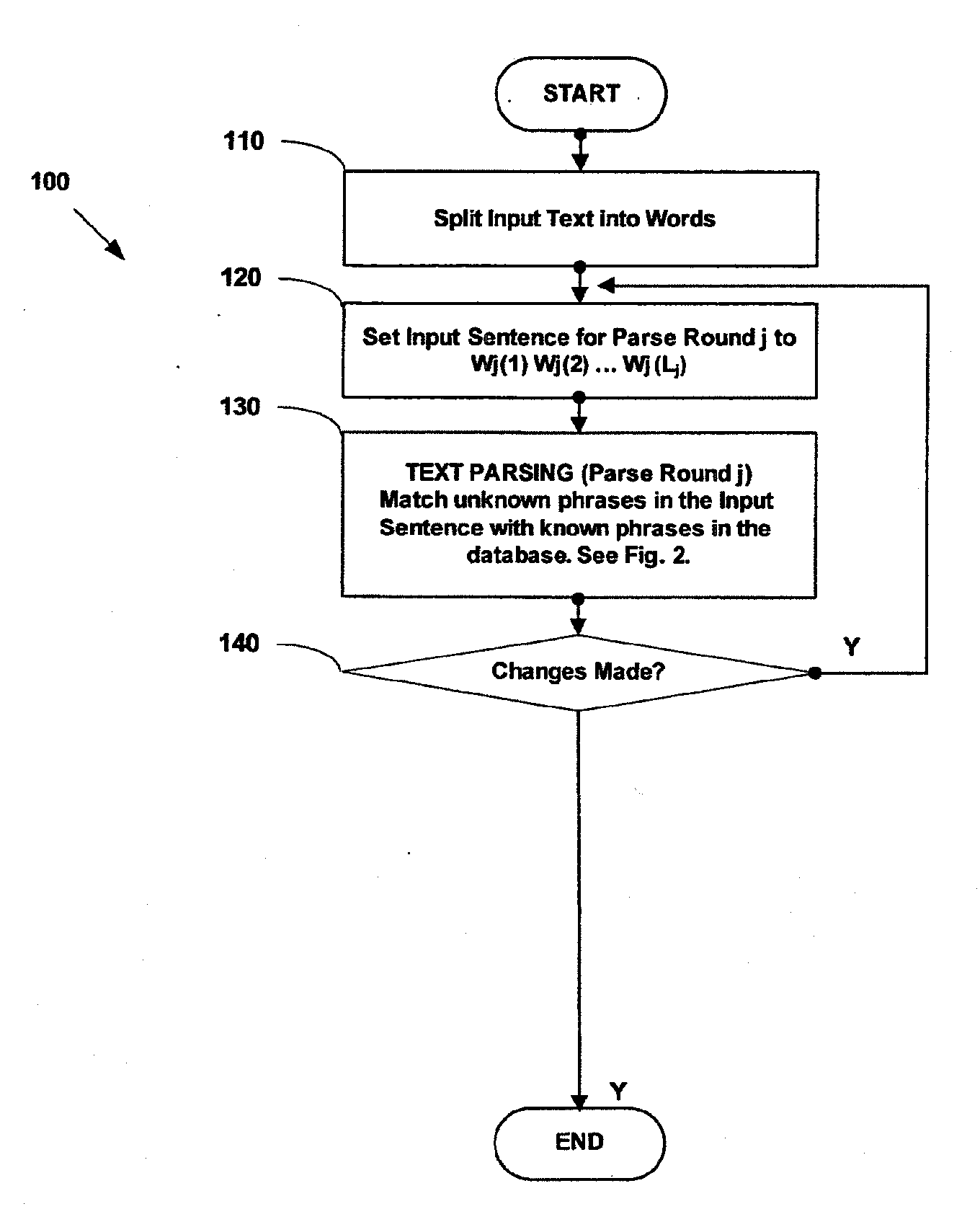Linguistic Analysis
a linguistic analysis and language technology, applied in the field of linguistic analysis, can solve the problems of long and complex tasks, programmers normally write code specifically, and approaches that do not usually cater to the use of idiomatic words and phrases
- Summary
- Abstract
- Description
- Claims
- Application Information
AI Technical Summary
Benefits of technology
Problems solved by technology
Method used
Image
Examples
example 1
[0099]An example of how an unknown literal phrase in a sentence is matched with a known literal phrase in the database is shown in FIG. 6. Assume that the input sentence to the Text Parsing 130 is “John is a jack of all trades” and during parsing the input sentence to the phrase matching procedure 215 is “jack of all trades”. The procedure first sets the current unknown word to “jack” and finds a list of literal phrases that begin with “jack”. In this example, there are two known literal phrases found: “jack of all trades” and “jack and the beanstalk”. The procedure then repeatedly match a word in the known phrase with the corresponding word in the input sentence using steps 320 and 330 in FIG. 3 until either a pair of unmatched words is found or a matching phrase is found. In this case, the first phrase is an exact match to the input sentence.
[0100]Note that there is no single index to a known phrase in the database. The mechanism to match a phrase starts with the word found in a l...
example 2
[0101]The steps performed by the invention in FIGS. 1, 2 and 3 will now be demonstrated with reference to an example in FIGS. 7A and 7B. Given an input sentence, the input text is first split into words using step 110 in FIG. 1. In the first parse round, the input sentence to the Text Parsing 130 is “The old Australian man wants a drink”. Referring to FIG. 2, step 210 matches the first unknown word “The” with a known word in the database. When the word is found, a list of phrases that are linked to “The” in the database is obtained using step 300 of FIG. 3. In this example, there is only one stored phrase linked to the word “The” and phrase matching procedure 215 fails to find a matching phrase. It may be common to have few literal Phrase patterns. These phrases are typically for literal phrases such as movie titles, idiomatic phrases, clichés, and proper names.
[0102]Since “The” is a literal word, the grammar use words associated with the word is obtained from the database after ste...
example 3
[0105]An example that illustrates the outcome of Text Parsing 130 in each parse round will now be described with reference to an example in FIG. 8. The purpose is to repeatedly match known phrases in the input sentence until a final sentence is obtained. In the first parse round, the input sentence to the Text Parsing 130 is “The cat ate the mouse.”. The Text Parsing 130 found four phrases “The cat”, “ate”, “the mouse” and “.” in the input sentence. These phrases are represented by their respective Overphrases, “[Noun: cat]”, “ate”, “[Noun: mouse]” and “.” in the second parse round (j=2). An Overphrase provides the next parse round with the grammatical use of the matched phrase and other semantically-based stored attributes, for example, a cat is [attribute: third-person], [attribute: singular] and an [attribute: animal].
[0106]When there are no changes made to the sentence in parse round 3, that is the phrases have converged, the words in the sentence will be converted to their resp...
PUM
 Login to View More
Login to View More Abstract
Description
Claims
Application Information
 Login to View More
Login to View More - R&D
- Intellectual Property
- Life Sciences
- Materials
- Tech Scout
- Unparalleled Data Quality
- Higher Quality Content
- 60% Fewer Hallucinations
Browse by: Latest US Patents, China's latest patents, Technical Efficacy Thesaurus, Application Domain, Technology Topic, Popular Technical Reports.
© 2025 PatSnap. All rights reserved.Legal|Privacy policy|Modern Slavery Act Transparency Statement|Sitemap|About US| Contact US: help@patsnap.com



